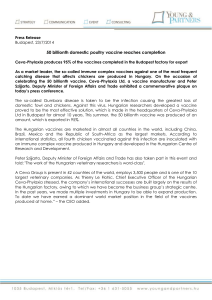the late industrial revolution in hungary
advertisement
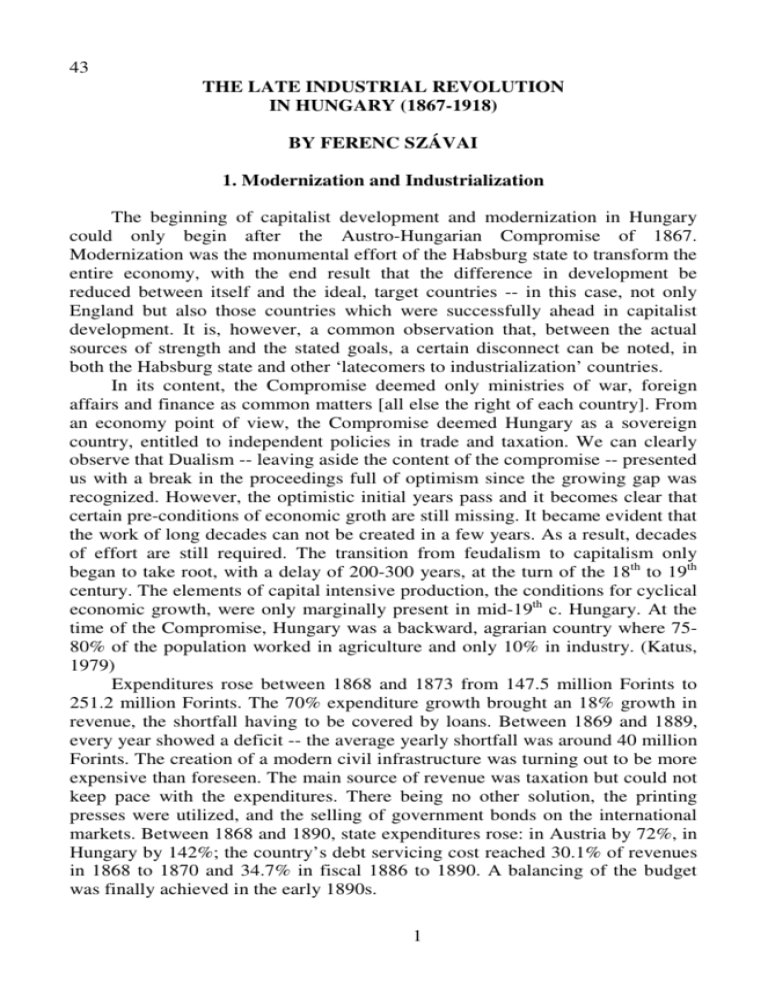
43 THE LATE INDUSTRIAL REVOLUTION IN HUNGARY (1867-1918) BY FERENC SZÁVAI 1. Modernization and Industrialization The beginning of capitalist development and modernization in Hungary could only begin after the Austro-Hungarian Compromise of 1867. Modernization was the monumental effort of the Habsburg state to transform the entire economy, with the end result that the difference in development be reduced between itself and the ideal, target countries -- in this case, not only England but also those countries which were successfully ahead in capitalist development. It is, however, a common observation that, between the actual sources of strength and the stated goals, a certain disconnect can be noted, in both the Habsburg state and other ‘latecomers to industrialization’ countries. In its content, the Compromise deemed only ministries of war, foreign affairs and finance as common matters [all else the right of each country]. From an economy point of view, the Compromise deemed Hungary as a sovereign country, entitled to independent policies in trade and taxation. We can clearly observe that Dualism -- leaving aside the content of the compromise -- presented us with a break in the proceedings full of optimism since the growing gap was recognized. However, the optimistic initial years pass and it becomes clear that certain pre-conditions of economic groth are still missing. It became evident that the work of long decades can not be created in a few years. As a result, decades of effort are still required. The transition from feudalism to capitalism only began to take root, with a delay of 200-300 years, at the turn of the 18th to 19th century. The elements of capital intensive production, the conditions for cyclical economic growth, were only marginally present in mid-19th c. Hungary. At the time of the Compromise, Hungary was a backward, agrarian country where 7580% of the population worked in agriculture and only 10% in industry. (Katus, 1979) Expenditures rose between 1868 and 1873 from 147.5 million Forints to 251.2 million Forints. The 70% expenditure growth brought an 18% growth in revenue, the shortfall having to be covered by loans. Between 1869 and 1889, every year showed a deficit -- the average yearly shortfall was around 40 million Forints. The creation of a modern civil infrastructure was turning out to be more expensive than foreseen. The main source of revenue was taxation but could not keep pace with the expenditures. There being no other solution, the printing presses were utilized, and the selling of government bonds on the international markets. Between 1868 and 1890, state expenditures rose: in Austria by 72%, in Hungary by 142%; the country’s debt servicing cost reached 30.1% of revenues in 1868 to 1870 and 34.7% in fiscal 1886 to 1890. A balancing of the budget was finally achieved in the early 1890s. 1 According to the estimate of Katus, the economy grew on an average of 2.5% to 3% annually between the Compromise and the turn of the century, translating to an almost 25% increase in per capita growth. In the second half of the 19th c., backward countries were able to augment relatively quickly the missing, or in short supply, means of production. The leading capitalist countries had foreign investments, in 1870, the equivalent of 15 billion Forints, which rose to 40 billion Forints by 1890. A significant amount was invested in Hungary. About half of capital expenditures between 1867 and 1890 were thusly financed, from French, German and Austrian sources. However, the major sources of internal capital accumulation in the two decades following the Compromise remained agriculture and trade. (Katus, 1970) The development of capitalist world economy entered a new phase in the years following 1890. The building of an extensive railway system in AustriaHungary, similar in characteristics to western European models, would not have been possible without foreign investment. Traditional internal sources of capital were insufficient to satisfy demand. Hungary, as part of the Habsburg Empire, later part of Austria-Hungary, was the target of a large volume of foreign investment since the beginning of the 19th century. Between 1867 and 1914, 6.8 billion Crowns of Austrian and foreign capital was invested in Hungary, amounting to 40% of capital investments (1990 to 1913, the amount of Austrian and foreign investment was 1.75 billion Crowns). During the period of the Dualism, the proportion of Austrian and foreign capital to internal capital accumulation, between 1867 and 1873, was 60:40; from 1873 to 1900, 45:55; from 1900 to 1913, 25:75. (Berend-Ránki, 1974) 2. Characteristics of industrialization, transportation and the capital credit system Hungary arrived at the threshold of modern industrialization at a relatively low level of economy development, behind those western and central European countries where the Industrial Revolution began at the end of the 18th or the first half of the 19th centuries. In the last three decades of the 19th century, the development of a modern and competitive manufacturing infrastructure required: a relatively developed general economic environment; an extensive railway network; trade and credit channels; significant entrepreneurial, organizational and technical expertise and experience; a large labour pool; and last but not least, capital investment. The Hungarian version of industrialization -- the late start and low starting point, its place in the international capital economy (this last one due, above all, to the labour specialization in the Habsburg monarchy) -- turned out uniquely. The textile industry, and generally the light industrial sector producing for the mass consumer market, played no role in industrialization until the end of the 19th century. In Hungary, the industrial revolution began in those industrial sectors which offered comparative advantages due to plentiful raw materials at hand and demand from more developed countries assured wide and dynamic markets, which, in turn, attracted foreign and local capital in the hopes of certain, and 2 large, profits. These, primarily, were the food industries, which played the leading role in our modern industrialization. During Hungary’s industrial development through the 19th century, two industrial sectors played the star role: food and heavy industry. After the Compromise, however, mechanization and large-scale factories became the prevailing form. The leading sector of our large industry was milling, which retained its primary position after the Compromise. During the 1860s, Hungary exported more flour than all the other countries of Europe combined. In short, the high profit and 26% interest on capital, ensured by the increased Austrian and German demand for wheat flour and the availability of cheap Romanian wheat, ensured an unprecedented growth in this sector until the end of the 1870s. At the turn of the century, in the export of flour, Hungary was second in the world only after the United States. Hungary’s ratio of wheat:flour was 33:67, while the large European grain exporters exported their grains almost entirely in unprocessed form. Fundamental changes were brought about by the higher technical level of industrial production, the transformation of organizational and plant setting, the shift from handycrafts to mechanized techniques, and the move from the traditional small factory to capital intensive large plants. In Hungary’s case, what made it much worse was that the traditional pre-industrial manufacturing base was smaller and more limited than the average. That industrial expansion could even begin was atrributable to several reasons: 1. The urging of the economic community. 2. The imported methods of production from more industrially developed countries. 3. State subsidies for industry. 4. The actions of financial institutions to finance industrial enterprises. 5. Growth in demand in the internal market. In the decades before World War I, the outstanding strategic role of banks in modern industrialization was a typically central European phenomenon. The focus of industrialization shifted, at the end of the century, to heavy industry producing industrial machinery. Primarily, the importance of machinery, tool and die making, construction materials and chemical industry grew, while industrial food production declined. The most advanced branch of our machinery factories, both in the numbers employed and the value created, was automotive production. (Magyarország gazdaságtörténete, 1996) The beginning of the railway network stretches back to the Széchenyi plan, according to which the capital is the central focus and linked to it are the complementary areas. The Magyar Államvasutak (MÁV, Hungarian State Railways) was founded relatively early. Secretary of State Gábor Baross (18831886), later minister (1886-1892) made the MÁV a well organized and profitable state enterprise. With the introduction of zoned tariffs, traffic increased six-fold. The final stage of 19th century railway nationalization took place between 1889 and 1891. Hungary’s 7.1 kms. / 100 km2 of rails compared favorably with 3 the western European average and surpassed the countries on the continent’s periphery. The volume of goods transported by rail increased to 85%, later climbing to 94%, making some products cheaper. Steam engine technology reached its almost full potential before World War I. The Államépítészeti Hivatal (State Infrastructure Office) was created in 1877 to oversee the network of roads and public transportation. The expansion of the network of roads coincided with the improvements to vehicular transport. Improvements to vehicular design and the internal combustion engine were the merit of Donát Bánki (1859-1922) and János Csonka (1852-1939). The capital’s public transportation grew four-fold between 1873 and 1910, Budapest’s ppopulation was in excess of 1.1 million. Double-decker buses played an important role. The subway line was inaugurated in 1896, second to London’s. In steamships, the Dunai Gőzhajózási Társaság (DGT, Danube Steamship Company) continued to hold a monopoly it has held since before the Compromise. At the turn of the century, the network of Hungarian navigable waterways stretched to 4,971 kms. Between 1891 and 1913, Fiume became Europe’s tenth largest port, after the founding of the Adria Magyar Királyi Tengerhajózási Rt. (Royal Hungarian Sea Transport Co.) by Gábor Baross in 1890. Development of the postal system: after 1887, the Hungarian Postal Service became independent and began a period of rapid development. In 1914, it had 4,812 vehicles, 3,697 horses and 738 postal railway carriages. The banking system of the Austro-Hungarian Empire was developed during the second half of the 19th century -- a strategic sector in the economic development. The major banks operated on a shareholder financed basis such as the Austrian Credit Anstalt, estd. 1855, and the two key institutions in Budapest: the Magyar Kereskedelmi Bank in Pest (Hungarian Bank of Commerce (1841)) and the Magyar Általános Hitelbank ( Hungarian Central Bank of Credit (1867)). Also, through investment from foreign capital (commercial banks) and partly through internal Hungarian sources (savings associations, credit unions, and local peoples’ banks.) The assets of Hungarian financial institutions in 1848 came to 3 million Crowns, rising to more than 1.5 billion Crowns in the last year of peace before the war. The Budapest Mercantile and Stock Exchange, founded in 1864, although overshadowed by the Vienna Stock Exchange, still represented a new stock trading venue in the Monarchy. May 9, 1873 is know as Black Friday, the day the Vienna stock market crashed, leading the the Depression of 1873. By 1880, the credit institutions were again in an expansion mode. In a decade, a further 172 banks and savings associations, and 336 credit unions were born. The other aspect of development was that in the Hungarian banking system, the central bank was reorganized on a dualist basis with the Austrian National Bank (the Österreichische Nationalbank (1816)) was reorganized in 1878 as the Osztrák Magyar Bank (AustroHungarian Bank). Servicing the financial needs of people with small needs was the mandate of the Postatakarékpénztár (Postal Savings Bank), established in 1886. The credit granting institutions were in close contact with the increasingly capital 4 intensive agricultural sector, their chief service was the lending for mortgages. It is a considered statement that, in no other country did banks play as important a role in financing a capital intensive economy as in the Austro-Hungarian Monarchy. (Kövér György, 1982) 3. Fundamental restructuring of agriculture and foreign trade Modern, capital intensive, industry for the agricultural sector is definable as the feeding of a population, providing the raw industrial materials required and supplying the workforce of other necessary sectors (industrial, trade and services). In the modernization of agriculture, it was first necessary to put agriculture on a scientific basis. Instead of traditional farming methods, a rationalized approach had to be initiated. A general trend of the era was an increase in the farmed areas; in 1913, there were 8.5 million (6 million kat. hold) acres more under cultivation than there were in 1865. Over half of the increase was in pasture and meadow lands, one-fifth in fallow fields and the rest in various other crops. The chief attribute of traditional farming was its almost entire basis on grain production. The key to the modenization of growing food crops is to be found in animal husbandry. During the years of Dualism, a certain backwardness was apparent in the numbers of animals raised, their value, and methods of storing silage. The tipping point in the traditional means of raising animals was reached in mid-19 th century; raising animals contributed 35% of the value of agriculture in 1870, 25% in 1890 and 30% in 1911. The greatest result was brought by the introduction of steam powered tractors in ploughs but the most mechanized process was threshing, using steam powered machinery. Mechanization was, of course, far behing that of western countries, especially the United States. The beginning of Hungarian modernization coincided with a western European boom. This period of prosperity, which pushed grain prices higher, was deal with by fundamental structural changes in Hungary, as part of the Monarchy’s unified market. Exports took a drastic change in direction: in 1840, animal products made up 60% and grains 26.5%. By 1870, the ratio was almost the opposite: grains made up 52.7% and animal products were 33.7%. The rationale was that, on the Monarchy’s protected markets, grains were more marketable, at prices higher than the average European markets. The shift to modern agricultural production began in Hungary but did not come to fruition. (Orosz István, 1989) It was the general trend of the era to see growth in the volume of international trade; between 1830 and 1890, Europe’s inter-country trade grew by tenfold. This rapid expansion was especially noticeable between 1850 and 1860, a result of the revolution in transportation and the growth of the railway network in Europe. Parallel to the rapid expansion, the makeup of the export items also underwent a change. During the 1840s, 89% to 90% of exports were 5 made up of unprocessed agricultural products, a large majority of it livestock and wool. After the Compromise, unprocessed agricultural products fell to 64% (grain made up 29% of it) and 36% was now inductrial products (food-stuffs represented 15%); grains and flour constituted 38% of the export total. In the last quarter of the 19th century, Hungary stood as the world’s second flour exporter, next to the United States. Besides grain and flour, the major export items were pork, wine, wool and lumber, although beginning in th e1880s, beef and sugar exports rose sharply. In imports, manufactured industrial goods made up around 80%. During the entire period, three quarters of those were consumer goods, mainly textiles and clothing. The value of trade in the common (duty free) zone within the Monarchy always exceeded approximately three quarters of Hungary’s total exports. It was especially in imports that the other parts of the Monarchy cornered a large, and growing, portion. Export data prove that the two halves of the Monarchy were increasingly dependent on each other. However, Austria was far less dependent on Hungary than the other way around. (Magyarország gazdaságtörténete 1996) 4. Growth of the middle class If we consider the growth of a middle class as a certain kind of sign of social advancement, then we must firstly take into account the activities and role of entrepreneurs. Entrepreneurship is a form of socially sanctioned work and distribution activity, which first arose in England. Two large groups came into being in the first half of the 19th century in Hungary: commercial merchants (mainly German-speaking) and Jewish wholesalers (having come from the western parts of the Monarchy). In the period under discussion, the Jewish wholesalers made spectacular progress in the Monarchy, and Hungary, too. The capitalized industrial entrepreneurs came from various groups. One source, obviously, was from commerce. Modern civil society is usually delineated into two main groups: the entrepreneurial and intellectual classes. The entrepreneurial group, as a class, made its appearance at the beginning of the 19th century (with some isolated examples, eg- Lázár Simon, who appeared in the last third of the 18th c.). Some became wealthy through trans-shipment commerce (initially acting as agents for foreign companies). Trade in agricultural products promised, and delivered, larger profits, aligned mostly to large estates. These traders made vast profits buying up local produce and selling it elsewhere (eg- the Ulmans and Wodianers). (Bácskai Vera, 1989). The capitalist entrepreneur stratum was swollen primarily by the founders of the Hungarian food industry, especially the mills and sugar industries (Fellner, Deutsch), but also by construction (Drasche, Gregersen). The advances of the late 1880s forced another shift in the middle class -- the way of the future of industrialization was intertwined with the banks -- and this is the reality on which the third generation of entrepreneurs grows up (Chorin, Hatvani, Weiss). 6 If we include the better-off members of the lower middle class (holders of 30-70 acres), then the middle class makes up 10-12%, while the lower classes comprise the 89-90% of society. This represents a sparse middle-class layer. In comparison, the per capita of GDP was only 29% of England’s and 38% of Germany’s (Fónagy, 2001). 5. A short assessment of economic advancement in the period of Dualism With that per capita proportion of the GDP, Hungary took a middle ranking position, in an economic development perspective, among the western and central European countries. Economic infrastructural assessment allows the conclusion that, between 1869 and 1890, those employed in industry grew by 3% while agricultural workers declined by 10%. In spite of it, the agricultural workers represented a total of 67.4% of the workforce; the numbers working in trade and finance doubled from 1.9%. Between 1890 and 1910, the agricultural workforce continued to decline, to 60% of the total, while industrial worker numbers grew to 18.3%; trade and financial worker numbers also continued to grow, reaching 6%. The contribution to the country’s GDP (without Croatia) was: 54% from agriculture, 31.2% from mining and industry, 14.8% from transportation and trade. In Austria, the comparable numbers were 34.5%, 45.4% and 20.1%. If we include the non-productive services, then agriculture’s contribution becomes 43.6%, mining and industry’s 25.3% and transportation’s 11.9%, the remaining 19.2% being the non-productive services. In Austria, the largest contribution was made by mining and industry at 36.7% while non-productive services were 19.1%, agriculture was 27.9% and transportation and trade was 16.35% (Katus László, 1983). 7 Bibliography Bácskai, Vera 1989: A vállalkozók előfutárai. Nagykereskedők Pesten a reformkorban. [The forerunners of the entrepreneurs. Wholesalers of Pest in the reform period] Magvető Kiadó Budapest Berend, T. Iván - Ránki, György 1974: Nemzeti jövedelem és tőkefelhalmozás Magyarországon 1867-1914. [National production and capital accumulation in Hungary 1867 to 1914] In. Berend, T. Iván - Ránki, György: Gazdaság és társadalom. Tanulmányok hazánk és Kelet-Európa XIX-XX. századi történetéről. Budapest. Magvető, pp. 36-58. Fónagy, Zoltán 2001: Modernizáció és polgárosodás 1849-1914. [Modernization and the growth of a civil society 1849 to 1914] Történelmi Kézikönyvtár. Debrecen. Csokonai Kiadó. Katus, László 1979: A tőkés gazdaság fejlődése a kiegyezés után. [Emergence of capitalbased economy after the Compromise] In. Magyarország története 6/2. 18671890. Főszerkesztő: Kovács Endre. Szerkesztő: Hanák Péter. Budapest. Akadémiai Kiadó, pp. 913-1038. Katus, László 1983: Magyarország gazdasága az első világháború küszöbén. [Hungary’s economy on the threshold of World War One] In. Magyarország története 7/1. 1890-1918. Főszerkesztő: Hanák Péter. Szerkesztő: Mucsi Ferenc. Budapest. Akadémiai Kiadó, pp. 394-401. Katus, László: Economic Growth in Hungary during the Age of Dualism (1867-1913). A Quantitative Analysis. In: Social-Economic Researches on the History of EastCentral Europe. Studia Historica. Akademiae Scientiarum Hungaricae. Edited by E. Pamlényi. Budapest, 1970. Kövér, György 1982: Iparosodás agrárországban. [Industrialization in an agrarian country] Magyar História. Budapest. Gondolat Magyarország gazdaságtörténete 1996: A honfoglalástól a 20. század közepéig. [From the Qonquest to the middle of the 20th century] Honvári János (szerk.). Budapest. Aula Kiadó. Orosz, István 1989: A mezőgazdaság modernizálása. [The modernization of agriculture] Magyar Tudomány, 1989/10-11, pp. 821-831. 8

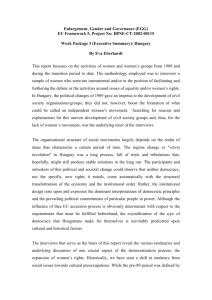
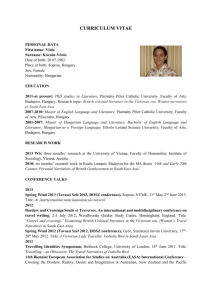
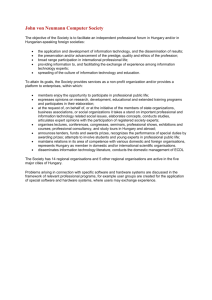

![View full document [DOC 121.00 KB]](http://s3.studylib.net/store/data/007311467_1-d846f7b116a73f74023d7a29ba436503-300x300.png)
